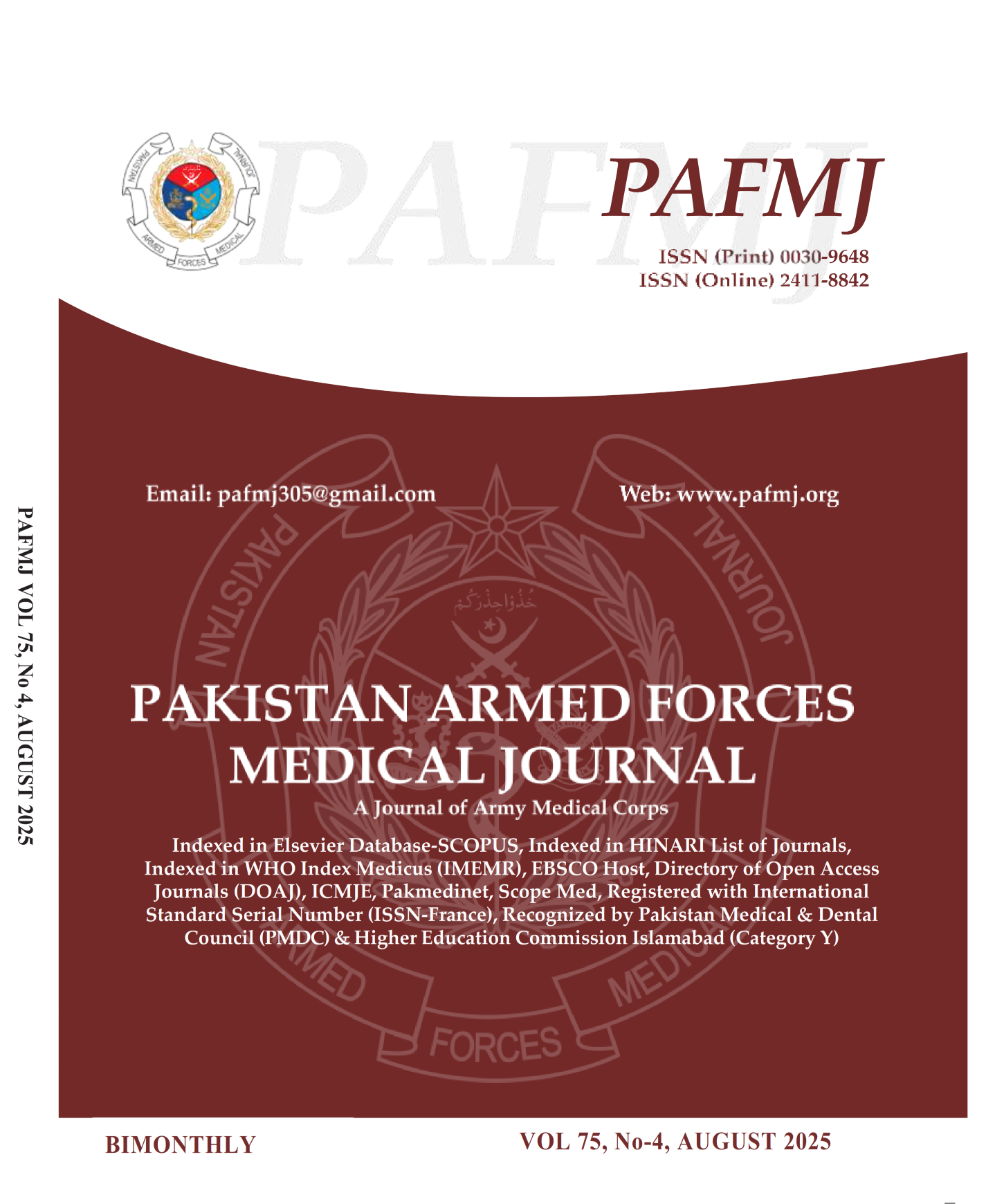Diagnostic Accuracy of Microbiological Culture for the Diagnosis of Helicobacter pylori Infection in Dyspeptic Patients taking Histopathological Examination as Gold Standard
DOI:
https://doi.org/10.51253/pafmj.v75i4.8683Keywords:
Helicobacter pylori; Histopathology; Microbiology; Dyspepsia; Proton Pump Inhibitors.Abstract
Objective: To accurately estimate the efficacy of microbiological culture technique in the diagnosis of H. pylori infection.
Study Design: Cross-sectional study.
Place and Duration of Study: Department of Gastroenterology, Pak Emirates Military Hospital (PEMH), Rawalpindi, Pakistan, from Jan to Sep 2021.
Methodology: Our study enrolled patients older than 18 years, who presented to PEMH during study period with history of chronic dyspepsia and underwent upper gastrointestinal endoscopy following which gastric tissue specimens were sent for histopathological and microbiological diagnosis. Cohen’s kappa coefficient (κ) was determined to estimate the statistical correlation between the two diagnostic measures.
Results: A total of 73 patients having a chronic history of dyspepsia lasting approximately 7.0±4.0 months were studied. Mean patient age was 45.8±14.72 years, with 63% participants being males and 62% of participants had consumed Proton Pump Inhibitors (PPIs) for <12 weeks. A positive diagnosis for H. pylori infection was seen among patients with poor socioeconomic status and with a shorter duration of PPI therapy. Cohen’s coefficient revealed only a moderate level of agreement between histopathological diagnosis and microbiological culture technique (κ=0.60). Furthermore, microbiological diagnosis had a drastically lower sensitivity (66.7%) and specificity (92.6%) with diagnostic accuracy of 78.1 % as compared to its counterpart.
Conclusion: Microbiological culture technique was found to have an inferior level of accuracy in the laboratory detection of H. pylori in contrast to histopathological diagnosis.
Downloads
References
1. Fischbach W, Malfertheiner P. Helicobacter Pylori Infection. Dtsch Arztebl Int 2018; 115(25): 429–436.
https://doi.org/10.3238/arztebl.2018.0429
2. Kumar S, Metz DC, Ellenberg S, Kaplan DE, Goldberg DS. Risk Factors and Incidence of Gastric Cancer After Detection of Helicobacter pylori Infection: A Large Cohort Study. Gastroenterology 2020; 158(3): 527–536.e7. https://doi.org/10.1053/j.gastro.2019.10.030
3. Santos MLC, de Brito BB, da Silva FAF, Sampaio MM, Marques HS, Oliveira ESN, et al. Helicobacter pylori infection: Beyond gastric manifestations. World J Gastroenterol 2020; 26(28): 4076–4093. https://doi.org/10.3748/wjg.v26.i28.4076
4. Sabbagh P, Mohammadnia-Afrouzi M, Javanian M, Babazadeh A, Koppolu V, Vasigala VR, et al. Diagnostic methods for Helicobacter pylori infection: ideals, options, and limitations. Eur J Clin Microbiol Infect Dis 2019; 38(1): 55–66. https://doi.org/10.1007/s10096-018-3389-6
5. Wang YK, Kuo FC, Liu CJ, Wu MC, Shih HY, Wang SS, et al. Diagnosis of Helicobacter pylori infection: Current options and developments. World J Gastroenterol 2015; 21(40): 11221–11235.
https://doi.org/10.3748/wjg.v21.i40.11221
6. Miftahussurur M, Yamaoka Y. Diagnostic Methods of *Helicobacter pylori* Infection for Epidemiological Studies: Critical Importance of Indirect Test Validation. Biomed Res Int 2016; 2016: 4819423. https://doi.org/10.1155/2016/4819423
7. Destura RV, Labio ED, Barrett LJ, Alcantara CS, Gloria VI, Daez MLO, et al. Laboratory diagnosis and susceptibility profile of Helicobacter pylori infection in the Philippines. Ann Clin Microbiol Antimicrob 2004; 3(1): 25. https://doi.org/10.1186/1476-0711-3-25
8. Ndip RN, MacKay WG, Farthing MJ, Weaver LT. Culturing Helicobacter pylori from clinical specimens: review of microbiologic methods. J Pediatr Gastroenterol Nutr 2003; 36(5): 616–622. https://doi.org/10.1097/00005176-200305000-00016
9. Gong YN, Li YM, Yang NM, Li HZ, Guo F, Lin L, et al. Centralized isolation of Helicobacter pylori from multiple centers and transport condition influences. World J Gastroenterol 2015; 21(3): 944–952. https://doi.org/10.3748/wjg.v21.i3.94
10. Malfertheiner P, Megraud F, O’Morain CA, Gisbert JP, Kuipers EJ, Axon AT, et al. Management of Helicobacter pylori infection—the Maastricht V/Florence Consensus Report. Gut 2017; 66(1): 6–30. https://doi.org/10.1136/gutjnl-2016-312288
11. Rojas-Rengifo DF, Mendoza B, Jaramillo C, Rodríguez-Urrego PA, Vera-Chamorro JF, Alvarez J, et al. Helicobacter pylori culture as a key tool for diagnosis in Colombia. J Infect Dev Ctries 2019; 13(8): 720–726. https://doi.org/10.3855/jidc.11313
12. Shiota S, Cruz MAJ, Abreu JAJ, Mitsui T, Terao H, Disla M, et al. Virulence genes of Helicobacter pylori in the Dominican Republic. J Med Microbiol 2014; 63(Pt 9): 1189–1196.
https://doi.org/10.1099/jmm.0.078305-0
13. Attila T, Zeybel M, Yigit YE, Baran B, Ahishali E, Alper E, et al. Upper socioeconomic status is associated with lower Helicobacter pylori infection rate among patients undergoing gastroscopy. J Infect Dev Ctries 2020; 14(3): 298–303. https://doi.org/10.3855/jidc.12366
14. Wang W, Jiang W, Zhu S, Sun X, Li P, Liu K, et al. Assessment of prevalence and risk factors of helicobacter pylori infection in an oilfield community in Hebei, China. BMC Gastroenterol 2019; 19(1): 186. https://doi.org/10.1186/s12876-019-1080-z
15. Talebi Bezmin Abadi A. Diagnosis of Helicobacter pylori Using Invasive and Noninvasive Approaches. J Pathog 2018; 2018: 9064952. https://doi.org/10.1155/2018/9064952
16. Costa S, Soares J-B, Gonçalves R. Efficacy and tolerability of culture-guided treatment for Helicobacter pylori infection. Eur J Gastroenterol Hepatol 2017; 29(11): 1258–1263.
https://doi.org/10.1097/MEG.0000000000000931
17. Lee JW, Kim N, Nam RH, Lee SM, Kwon YH, Sohn SD, et al. Favorable outcomes of culture-based Helicobacter pylori eradication therapy in a region with high antimicrobial resistance. Helicobacter 2019; 24(2): e12561. https://doi.org/10.1111/hel.12561
18. Arslan N, Yılmaz Ö, Demiray-Gürbüz E. Importance of antimicrobial susceptibility testing for the management of eradication in Helicobacter pylori infection. World J Gastroenterol 2017; 23(16): 2854–2869. https://doi.org/10.3748/wjg.v23.i16.2854
Downloads
Published
Issue
Section
License
Copyright (c) 2025 Naveed Abbas, Muhammad Hafeez, Muhammad Asad Sultan Khan, Muhammad Farhan Shahid, Hassam Abdullah, Hamza Bin Tariq

This work is licensed under a Creative Commons Attribution-NonCommercial 4.0 International License.















